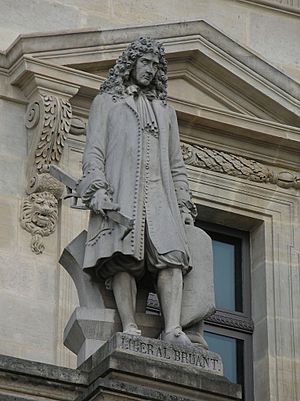Libéral Bruant facts for kids

Libéral Bruant (born around 1635, died November 22, 1697) was a famous French architect. He is most well-known for designing the Hôtel des Invalides in Paris. Libéral Bruant came from a family of architects. Many members of his family were architects from the 1500s to the 1700s.
Contents
The Life and Works of Libéral Bruant
Early Projects and Big Hospitals
In 1660, Libéral Bruant was chosen for an important project. He worked on an old army building (an arsenal) that belonged to King Louis XIII. This building, called the Salpêtrière, was being changed into a huge hospice. A hospice is a place that cares for people who are sick or elderly. This building later became the Pitié-Salpêtrière Hospital, which is still a very large hospital today.
Designing the Hôtel des Invalides
One of Bruant's most famous designs is the Hôtel des Invalides in Paris. This grand building was made to house and care for old and sick soldiers. Another famous architect, Jules Hardouin Mansart, worked with Bruant on this project. Mansart later added the impressive dome that you see on the Invalides today.
Bruant's Own Home
In 1685, Bruant built a beautiful private mansion, called an hôtel particulier, for himself. This house is in the Marais area of Paris. Today, this building is home to the Bricard Lock Museum (Musée de la Serrure). The outside of the house is made of golden limestone and has a style called Baroque. It has interesting windows and sculptures, including busts (sculptures of heads and shoulders) in oval shapes.
A Royal Architect
In 1671, King Louis XIV created the Académie royale d'architecture. This was a special group for the best architects in France. Libéral Bruant was one of the first eight members chosen for this important academy. He died in Paris on November 22, 1697.
Understanding Bruant's Architectural Style
Libéral Bruant's buildings show a style called High Baroque. This style is known for being grand, dramatic, and full of rich details. If you look at the main entrance of the Invalides, designed by Bruant, you'll see many military decorations.
His style is different from the later Late Baroque style of Jules Hardouin Mansart. Mansart's buildings, like the dome of the Invalides, are still grand but are often more calm and balanced. Comparing their work at the Invalides helps us see the differences between these two important Baroque styles.
See also
 In Spanish: Libéral Bruant para niños
In Spanish: Libéral Bruant para niños
- Architecture of Paris
- Les Invalides

